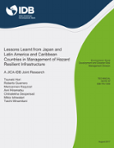Lessons Learnt from Japan and Latin America and Caribbean Countries in Management Hazard Resilient Infrastructure: A JICA-IDB Joint Research
Date issued
Aug 2017
Subject
Risk Management;
Natural Disaster Risk Management;
Coastal Hazard;
Sustainable Infrastructure
Category
Technical Notes
The Latin America and the Caribbean (LAC) region is one of the most disaster-prone areas in the world. Disasters have increasingly devastated the development effectiveness of the LAC countries. Had infrastructure been constructed with additional measures to prevent collapses due to natural hazard impacts, the region would have saved in the long run a significant amount of the public, private and human capital allocated to repairs and reconstruction. A key question is: what are the factors involved in preventing infrastructure collapse due to natural hazard impacts and how might these measures be implemented? This paper discusses the LAC countries’ sustainable infrastructure that has been shown to be resilient, continuing to operate without collapse even during hazardous events. The study reviews (i) the good practices for reducing vulnerability in Japan, (ii) the overall progress of LAC countries on disaster risk management, and (iii) the recent infrastructure damages due to disasters in LAC region and identifies lessons. Finally, using a comparative analysis of a selected case studies in LAC and Japan, the study identifies four approaches for hazard resilient infrastructure in the LAC region.



